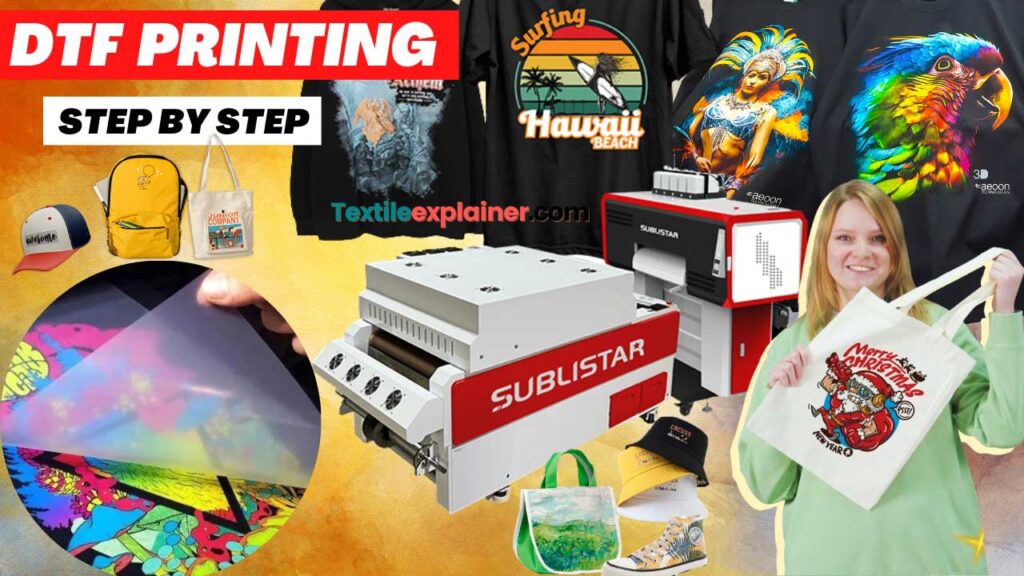Ultimate Overview to DTF Printing Methods for Magnificent Fabric Layouts
Starting the trip of understanding DTF printing strategies can open a world of possibilities for producing visually fascinating fabric layouts. As the fabric sector remains to evolve, staying ahead of the contour with cutting-edge printing techniques is essential. In this guide, we will certainly discover the intricate details of DTF printing, from understanding the essential basics to unraveling advanced color techniques that can elevate your designs to new elevations. Keep tuned as we explore the nuances of picking the appropriate products, improving the printing process, and getting over usual challenges to attain magnificent results.
Understanding DTF Printing Essentials
DTF printing, a procedure that involves moving layouts from a special movie to textiles making use of heat and stress, develops the structure of fabric printing techniques. The initial step in DTF printing entails creating or choosing a design that will be published onto the fabric.
The final result is a stunning, lasting textile layout that is cleanable, adaptable, and immune to fading. Generally, recognizing the essentials of DTF printing is essential for understanding this modern textile printing technique.
Choosing the Right Textile Materials
Having developed the foundational concepts of DTF printing methods for fabric designs, the next essential consideration exists in selecting the ideal fabric products to complement this ingenious process properly. Additionally, the stretchability of these products can suit the warm transfer procedure involved in DTF printing without distorting the layout. By selecting the best fabric materials, designers can take full advantage of the potential of DTF printing to create stunning and lasting fabric styles.

Grasping the Printing Process
To excel in DTF printing methods for fabric styles, mastering the printing procedure is necessary for accomplishing consistent and top quality results. The temperature level, pressure, and period of warm application must be meticulously managed to make certain appropriate adhesion of the style to the textile. By refining each of these steps in the printing procedure, designers can regularly create stunning and long lasting fabric styles with DTF printing strategies.
Enhancing Designs With Shade Strategies

Furthermore, experimenting with color slopes can bring a sense of motion and fluidity to the style. By mixing shades flawlessly, a slope result can be attained, including a dynamic and modern touch to the fabric style. Furthermore, using color obstructing methods can produce striking and strong visuals by juxtaposing different strong colors in distinct areas of the layout.
Additionally, incorporating metal or neon colors can offer a distinctive and special aspect to the fabric layout, making it attract attention and show a feeling of vibrancy. When strategically applied, these color strategies can raise the overall visual appeal of fabric designs, making them extra unforgettable and captivating.
Troubleshooting Common DTF Printing Issues
After checking out numerous color strategies to improve fabric layouts, it is vital to deal with usual DTF printing problems that might occur throughout the production procedure. One usual problem is inadequate adhesion, which can arise from improper curing times or temperatures. To solve this trouble, make sure that the treating setups are accurate and that the sticky made use of is appropriate for the details fabric being printed on. An additional frequent challenge is color variances, where shades may show up differently than anticipated. This can be created by incorrect shade profiles or setups in the printing software. To tackle this, confirm the shade setups and profiles to ensure they match the desired layout. Furthermore, problems with picture quality and intensity can take place as a result of low-resolution photos or improper printing see techniques. To look at here resolve this, constantly make use of top quality pictures and adjust the printing setups for optimum quality. By being aware of these usual troubles and applying the necessary troubleshooting steps, you can boost the general quality of your DTF printed textile designs.
Final Thought
Finally, understanding DTF printing techniques is essential for developing magnificent textile styles. By understanding the basics of DTF printing, picking the ideal materials, and enhancing layouts with color techniques, one can attain excellent results. It is necessary to repair usual problems that may emerge throughout the printing procedure to make sure a successful end result. With technique and interest to information, one can produce one-of-a-kind and stunning textile styles using DTF printing methods.
DTF printing, a process that entails moving styles from an unique film to textiles making use of heat and pressure, develops the structure of fabric printing strategies.Having established the foundational concepts of DTF printing techniques for fabric designs, the next important consideration exists in selecting the suitable fabric materials to enhance this innovative process successfully. By picking the appropriate textile materials, designers can make the most of the capacity of DTF printing to develop resilient and magnificent fabric designs.
To stand out in DTF printing strategies for textile designs, grasping the printing process is necessary for attaining consistent and top quality outcomes. DTF Printing. By refining each of these actions in the printing procedure, developers can constantly generate sturdy and stunning textile designs with DTF printing strategies
Comments on “DTF Printing Demystified: Whatever You Required to Find Out About Direct-to-Film”